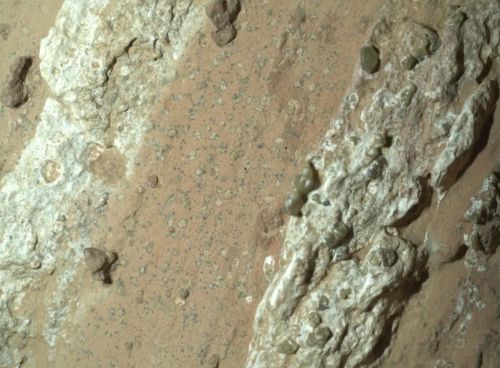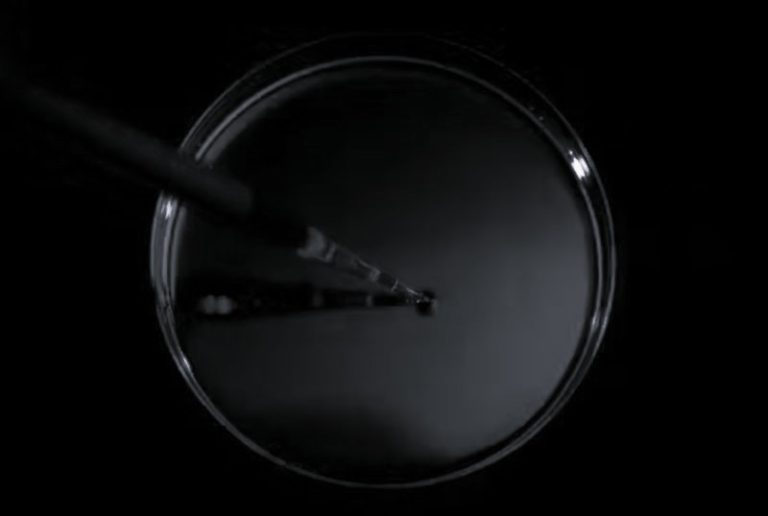

The timeline for a Mars Sample Return mission stretches into the next decade, but this discovery makes the effort feel less like speculation and more like necessity.

By Matthew A. McIntosh
Public Historian
Brewminate
The Sediment That Holds a Question
NASA announced that its Perseverance rover has discovered what may be a potential biosignature in the mudstones of Jezero Crater, a site long believed to have once hosted a lake and active river system. The story quickly spread across major outlets, from Reuters to the Washington Post, often under headlines hinting that “life has been found on Mars.” That is not what happened. What was uncovered is subtler, a collection of features and minerals that resemble what we know life produces on Earth, but that could also have non-biological origins.
In one sample nicknamed Sapphire Canyon, Perseverance’s instruments detected dark nodules, concentric rings, and the presence of minerals like vivianite and greigite. On Earth, these are frequently linked to microbial activity in watery environments. The rover also picked up signs of organic carbon within the rock. This combination (structure, mineral, and chemistry) gives scientists reason to consider biology as one possible explanation. Yet as NASA itself stressed, “potential” does not mean proof.
What Scientists Mean by “Potential Biosignature”
The phrase is not new. A NASA explainer defines a potential biosignature as any substance, pattern, or feature that could be created by life but might also arise from purely chemical processes. This ambiguity is not a flaw in science but a safeguard. It is precisely because rocks can mimic biology that scientists are cautious in their claims.
Astrobiologists remember well the controversies of the past. The 1996 announcement of possible microfossils in a Martian meteorite stirred the world, only to unravel as inorganic explanations proved more convincing. Methane detections on Mars, too, have swung between biological excitement and geochemical caution. In this context, restraint is not timidity—it is discipline born of experience.
Ancient Waters and the Context of Habitability
Jezero Crater was chosen as Perseverance’s landing site because orbital imagery showed an ancient river delta. Billions of years ago, sediments poured into a standing lake, creating layered deposits similar to those that on Earth often trap chemical and biological signals. The mudstone now under study was laid down in this watery context, a reminder that Mars once carried the essential ingredients for life as we know it.
Mudstones are valuable because they preserve fine-grained detail. On Earth, they have captured microbial mats and isotopic traces of ancient organisms. In Jezero, Perseverance has revealed bleaching patterns and mineral reactions that resemble such terrestrial records. Even if these Martian features prove abiotic, they deepen the picture of Mars as a planet that was once habitable, not barren from the beginning. The Conversation highlights that habitability itself is a significant discovery, independent of life.
A Timeline of Martian “Life Hints”
The Perseverance finding belongs to a much longer story, one marked by cycles of hope, scrutiny, and recalibration.
In the late 1970s, NASA’s Viking landers carried experiments designed to detect metabolic activity in Martian soil. One experiment produced results that some interpreted as chemical signs of life, but later analysis suggested the reactions could be purely inorganic. The ambiguity has lingered for decades, fueling debate.
The 1996 announcement of microfossil-like structures in a Martian meteorite, ALH84001, generated headlines worldwide and even presidential remarks. Yet further investigation revealed that non-biological processes could produce the same features. What once seemed like fossils of Martian microbes now stands as a cautionary tale.
More recently, both the Curiosity rover and orbiting satellites detected fluctuating levels of methane. On Earth, methane often signals biological activity, but geologists showed that subsurface chemistry could also explain the measurements. Methane became another case of “maybe,” rather than “yes.”
Now Perseverance adds a new chapter. The nodules and minerals of Jezero do not prove life existed, but they are more suggestive than most earlier finds. They add to the momentum of possibility, pushing the scientific community closer to questions that only returned samples may answer.
Between Hype and Humility
The cultural leap from “potential biosignature” to “life found” reflects a familiar tension. Public imagination longs for a cosmic companion, while scientific language struggles to hold the line between possibility and certainty. The last time Mars flirted with such headlines, it was with organic molecules found by Curiosity, which turned out to be ambiguous in origin. Each cycle of excitement followed by correction makes the community more careful.
For researchers, this moment is not about vindicating long-held hopes but about refining hypotheses. Abiotic chemistry on Mars is complex. Iron redox reactions and groundwater alterations can mimic biological textures. By testing these alternatives, scientists do not dampen the romance of life on Mars; they sharpen the criteria by which genuine evidence will one day be recognized.
Why the Debate Matters
The possibility of a biosignature, even if it dissolves under scrutiny, changes how we view Mars. It confirms that the planet has repeatedly offered conditions favorable to life. It directs future sampling strategies. And it forces us to wrestle with the difficulty of detecting life at planetary scales, where absence of evidence is not evidence of absence.
NASA’s rover cannot provide the final word. The instruments on Perseverance are remarkable, but the decisive work will happen when samples are returned to Earth. Laboratory techniques (high-resolution imaging, isotopic studies, organic molecule analysis) are needed to cross the threshold from “possible” to “proven.” Until then, what the rover offers is the seed of a question, not its answer.
Looking Ahead
The timeline for a Mars Sample Return mission stretches into the next decade, but this discovery makes the effort feel less like speculation and more like necessity. Rocks like Sapphire Canyon are exactly the kind of material that could settle debates lasting generations.
For now, we are left with a paradox. Mars may be silent, but its rocks are whispering. They suggest a past in which water was abundant and chemistry ran rich, and they tempt us with shapes and minerals that look uncannily like the fingerprints of life. The silence may never break into certainty, but in the search itself there is meaning.
Originally published by Brewminate, 09.19.2025, under the terms of a Creative Commons Attribution-NonCommercial-NoDerivatives 4.0 International license.


